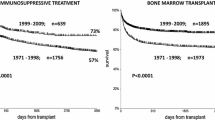Abstract
Between January 1983 and December 1997, 88 patients (36 female, 52 male, median age 37 years, range 19–57) with chronic myelogenous leukemia (CML) underwent allogeneic bone marrow transplantation (BMT) at the University Hospital of Vienna. Sixty patients were in chronic phase, 18 in accelerated phase, and ten in blast crisis. Marrow donors were HLA-identical siblings for 64 patients (BM 58, PBSC 6), 2-antigen-mismatched related donors (RD) for two, HLA-identical unrelated donors (URD) for 17, and 1-antigen-mismatched URD for five. The median time from diagnosis to BMT was 22 months (range 2–91), and 63 patients had received prior interferon (IFN)-alpha therapy, 46 (73%) for more than 6 months. Conditioning therapy consisted of cyclophosphamide (CY) and total body irradiation (TBI) in 71 patients and CY and busulfan (BU) in 16. One patient received etoposide and TBI. For graft-versus-host disease (GVHD) prophylaxis methotrexate (MTX) was given to 12 patients, MTX and cyclosporin A (CSA) to 67, CSA alone to four, and CSA and methylprednisolone to five. Durable engraftment was documented in 80 of 82 patients (98%). As of December 31, 1997, 52 patients (59%) were alive, 38 (58%) after sibling transplantation with a median observation time of 73 months and 14 (64%) after URD transplantation with a median observation time of 12 months. Probability of overall survival is 59%, for patients undergoing transplantation in chronic phase and 44% for patients undergoing transplantation in advanced stage CML. Probability of disease-free survival (DFS) after sibling and URD BMT is 55% and 59%, respectively. Ten patients (12%) experienced relapse of CML. Transplant-related mortality was 32% both after RD and after URD transplantation. Acute GVHD occurred in 53 of 80 evaluable patients (66%), consisting of grade III or IV in 14 patients (18%). Chronic GVHD developed in 40 of 63 eligible patients (63%), including extensive disease in 26 patients (41%). Thus, sibling and URD BMT offer high cure rates with acceptable toxicity to patients with CML.
Similar content being viewed by others
Author information
Authors and Affiliations
Additional information
Received: October 27, 1998 / Accepted: May 25, 1999
Rights and permissions
About this article
Cite this article
Reiter, E., Greinix, H., Keil, F. et al. Long-term follow-up of patients after related- and unrelated-donor bone marrow transplantation for chronic myelogenous leukemia. Ann Hematol 78, 507–513 (1999). https://doi.org/10.1007/s002770050547
Issue Date:
DOI: https://doi.org/10.1007/s002770050547




